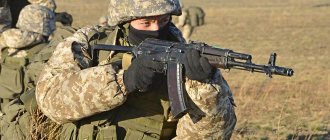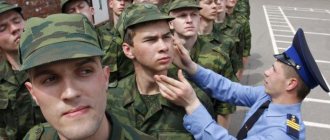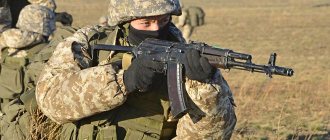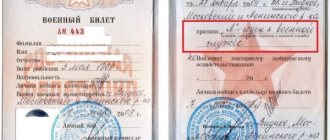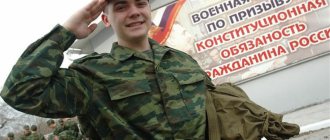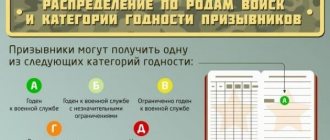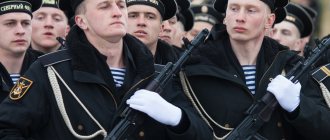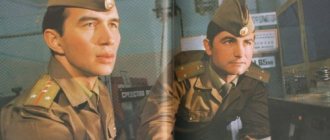- home
- Articles
- Suitability categories
- Fitness category "B"
»
»
»
Updated: September 18, 2021
Free hotline for conscripts and their parents
8
During conscription events taking place at the military registration and enlistment office, all citizens who must be involved in compulsory military service are required to undergo a medical examination. Based on the results of the medical examination, the health group of each young person is determined. Information about what category “B” means on a military ID can be found in this article.
What does category “B” mean on a military ID?
Each conscript’s fitness category is established on the basis of the corresponding article of a special document called “Schedule of Diseases.”
It contains a complete list of possible pathologies and is used to determine which group the conscript belongs to based on his state of health.
Fitness category for military service “B” is the most common.
It is assigned in the following cases:
- in the presence of any pathologies from the “Schedule of Diseases” of the corresponding stages and degrees;
- when making borderline diagnoses;
- if the level of preparation for conscription activities does not correspond.
In general, the presence of category “B” means that the conscript is fit for service in the Russian army with minor restrictions.
Attention! To prevent young people with diagnoses of different severity from being sent to the same troops, a destination indicator has been introduced that divides this group into four subcategories: “B-1”, “B-2”, “B-3” and “ B-4".
Categories “B-1”, “B-2” in the army
Category “B-1” and “B-2” are assigned if a citizen has minor deviations in health, which allow him to serve in the army with minimal restrictions without any consequences. For example, this group is assigned when diagnosing mild allergies or any chronic diseases that do not cause dysfunction of human organs.
With the fitness category “B-1”, a conscript is assigned to the following branches of the military:
- special forces units;
- Marines;
- border guard troops;
- Airborne and Airborne Forces units.
If, by decision of the medical commission, a young man is assigned category “B-2,” he can be sent to the submarine or surface fleet or to serve as a driver or crew member of a tank, self-propelled gun, or engineering vehicle.
Attention! The listed troops recruit young people with excellent physical fitness and certain anthropometric data.
Fitness category "B-3"
The “B-3” fitness category mark on a military ID is most common, since this group is indicated in the presence of most health disorders from the list given in the “Schedule of Diseases”, minor functional deviations in the functioning of human organs, as well as residual phenomena of cured pathologies and fractures.
If assigned to the “B-3” category, the conscript is considered fit for service in the armed forces of the Russian Federation, but with restrictions in the form of a reduction in the intensity of physical activity.
If the fitness category column in the military ID contains information that the young man has been assigned group “B-3”, the conscript can be sent to the army as:
- driver and crew member of infantry fighting vehicles, armored personnel carriers and missile launchers;
- specialist of chemical parts, including fuels and lubricants;
- specialist in the management and maintenance of anti-aircraft missile systems.
Need help getting out of the army?
Call us at 8 (800) 550-25-66 or leave a request and we will answer any questions about the army and obtaining a military ID.
Request a call
With this fitness category, it is impossible to get into elite troops, special forces units, as well as into troops to which conscripts of categories “B-1” and “B-2” are sent.
Anthropometric and health indicators that correspond to category “B-3”:
- height - 155–180 cm;
- visual acuity without correction - 0.5–0.1;
- hearing - the ability to distinguish speech spoken in a whisper at a distance of 4–6 m;
- no disturbances in color perception.
Fitness category "B-4"
Fitness category “B-4” is similar to group “B-3”. It also does not exempt the conscript from military service, but implies more significant restrictions on the intensity of physical activity.
Some young people believe that the “B-4” category exempts them from military service, since it is the last of all categories in this group. But this is a mistaken opinion. The basis for assigning this category may be deviations in health status, which are not an obstacle to service in military units. For example, diseases such as grade II flat feet, grade II scoliosis or grade II chest deformity.
Since “B-4” is the lowest category of this group, many conscripts think about which troops they can join based on their health.
It can be:
- radio engineering parts;
- protection and defense of missile systems;
- other troops and units that do not place great demands on the health of military personnel.
Anthropometric and health indicators that correspond to category “B-4”:
- height - up to 180 cm;
- corrected visual acuity - from 0.5/0.1 or 0.4/0.4;
- hearing - the ability to distinguish words spoken in a whisper at a distance of 3–5 meters;
- no disturbances in color perception.
Which troops will they be sent to serve in?
Depending on the category, the types of troops to which conscripts can be sent are determined.
With category B
In peacetime, conscripts who want to give back to their homeland are sent to perform alternative service. Young people can become orderlies, volunteers, factory workers, and so on.
In wartime, citizens with category B are sent to work in the rear in accordance with their existing specialty and ensure the uninterrupted supply of goods and services necessary for advanced military units.
With category B
With subcategory B1, a young man can be called up:
- to special forces
- to the Marine Corps
- in the Airborne Forces
- to border troops and assault brigades
Conscripts from subcategory B2 are sent to serve:
- to the navy (navy)
- to the tank forces
- National Guard
- surface fleet
- engineering troops
Category B3 allows you to perform military service:
- in the missile forces
- in the engineering troops
- in chemical parts
- in motorized rifle troops
- in the troops of the Ministry of Internal Affairs, including guard units
Young people can be anti-aircraft gunners, drivers of special equipment (infantry fighting vehicles, armored personnel carriers, etc.), specialists in spare parts for vehicles, fuels and lubricants and other chemical compounds, specialists in servicing anti-aircraft missile systems, and so on.
Conscripts from subcategory B4 can be sent for military service:
- in signalmen
- to radio engineering units
- to the troops for the protection of missile systems
Decoding the categories of suitability for military service
Decoding of all categories of suitability for military service:
- “A” - the young man is fit for military service and can be drafted into any army without any restrictions.
- “B” - the conscript is fit to perform military duties, but with minor restrictions. Since this group can be assigned in the presence of diseases that occur both in a mild form and in a more severe form, it is usually divided into four subcategories: “B-1”, “B-2”, “B-3” and “B-3”. B-4".
- “B”—the conscript is limitedly fit for service. He receives a military ID and is released from the army in peacetime, but in the event of hostilities he can be called up from the reserves.
- “G” - the young man is temporarily unfit for military service. A young person may receive a deferment to undergo a course of treatment. After completing this period during the first conscription, he is obliged to report to the military registration and enlistment office and undergo a medical examination again. If the medical commission finds improvements in his health, the young man may be called up for service. Otherwise, he will be given another deferment or issued a military ID.
- “D” - the conscript is not fit for military service. The young man receives a military ID and is removed from the military register. He cannot serve in the army either in peacetime or in wartime.
Military medical expert commission
To conduct a medical examination of a conscript and assign him one or another fitness category, a special commission is created at the military registration and enlistment office. It includes medical specialists, each of whom examines the young man and studies his medical history. Anamnesis is necessary to obtain relief, deferment or release from service.
The commission includes:
- An ENT doctor who diagnoses diseases of the ears, nose and throat;
- specialist in disorders of the functioning of the central nervous system and peripheral nerves (neurologist);
- medical vision specialist (ophthalmologist);
- a doctor who determines the presence of mental disorders (psychiatrist);
- dentist;
- surgeon;
- therapist.
Based on the totality of the results, the commission gives an opinion on the general state of health. The conscript is assigned a category (health group), according to which it is determined which troops he can be sent to and possible restrictions on the performance of official duties. In case of a controversial situation, preference is given to the group with more limited capabilities.
Important! Medical representatives of the military registration and enlistment office commission only give an opinion on the health of the young man in their medical field based on the results of the examination. They do not diagnose the disease and do not treat the detected disease.
In total, five categories of health are accepted, which are designated on the military ID by capital letters of the Russian alphabet (A, B, C, D, D). Only men with categories A and B can serve in the Armed Forces under contract.
Brief explanation of categories
| Litera | Designation |
| A | valid without restrictions |
| B | valid with minor restrictions |
| IN | limited (partially) fit, deferment for treatment provided |
| G | partially unfit, given a deferment for inpatient treatment |
| D | unfit, full exemption |
When determining the category at the military registration and enlistment office, making a decision on deferment or release from conscription service, medical specialists are guided by a single document called the “Schedule of Diseases”.
Where will they go to work?
When applying for a job that involves conferring a rank and carrying a weapon, it is mandatory to present a military ID, which indicates the category of suitability for military service.
Attention! Health group “B” provides the applicant with great opportunities for employment in any structures, including in the Ministry of Internal Affairs.
Do they hire you to work in the police?
The possibility of employment in the police with suitability group “B” depends on the subcategory assigned to the applicant:
- “B-1” allows you to work in all intended groups;
- B2 - the possibility of enrollment in all groups, but in the first - with certain restrictions;
- B3 - access to work in the third and fourth groups;
- B4 - employment opportunity only in the fourth group.
The first group includes:
- departments for combating organized crime;
- OMON, SOBR, etc.;
- PPS and traffic police of the traffic police working on the roads;
- security of objects and special cargo;
- private security capture groups;
- drivers of task forces;
- dog handlers;
- employees taking part in firefighting.
The second group includes:
- rapid response units;
- special teams at sites;
- drivers (except for task force drivers);
- instructor groups.
Group 3 includes:
- criminologists;
- public security police;
- duty units;
- employees of the investigative department;
- forensic experts;
- mobilization and personnel departments;
- courier service;
- second special departments;
- fire service employees (except those assigned to group 1);
- technical departments;
- employees of the operational and technical department.
Fourth group:
- passport and visa service;
- rear staff;
- medical workers;
- specialists from the financial and economic department;
- computer support and database centers;
- private security (except for capture groups);
- research centers and departmental institutes;
- other services.

